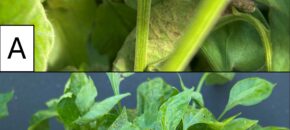There have been a few reports of Southern blight (Sclerotinia rolfsii) and White mold (Sclerotinia sclerotiorum) on tomato and pepper in New Jersey. Southern blight is much more common in vegetable areas south of the state where summer temperatures remain hotter (above 90°F) for longer periods of time. Like white mold, it can survive in […]
Continue reading...Diagnosing Verticillium Wilt in Eggplant
Verticillium wilt has been reported in eggplant this summer. It is a common soil-borne fungal pathogen that once it has infested soil can remain for a very long time. Verticillium wilt is caused by either Verticillium albo-atrium or Verticillium dahlia and has a wide host range (over 200 plant species). Both pathogens can survive (overwinter) […]
Continue reading...Controlling phomopsis fruit rot in eggplant
Phomopsis blight is caused by the fungal pathogen, Phomopsis vexans. It survives between seasons in the soil on infested plant debris. Although the pathogen can infect stems and older leaves, fruit infections are most prominent. Cankers that develop on stems and branches can cause the entire plant to collapse and die. Circular, grayish spots may […]
Continue reading...Veg IPM update 7/11/25

Greetings from the Veg IPM team! Sweet Corn Corn earworm moth captures are increasing in the southern part of the state leading to 3- or 4-day spray intervals being needed at all trapping locations south of interstate 195. When temperatures are high (>85 degrees F), shorten the spray interval by one day. Rotation is important […]
Continue reading...Cucurbit Downy Mildew Alert – 7/11/25 – Cucumber
Cucurbit downy mildew has been reported on cucumber in Central New Jersey. This is the first report of CDM this growing season in the state. All cucumber and cantaloupe fields need to be scouted on a daily basis and preventative fungicide programs need to be initiated. For more information on CDM and its control please […]
Continue reading...Preparing for cucurbit downy mildew in 2025
In 2004, cucurbit downy mildew re-emerged in the US with a vengeance causing significant losses in cucurbit production. In most years prior to this, concern for CDM control was minimal, since the pathogen arrived late in the growing season (in more northern regions), or the pathogen caused little damage, or never appeared. After 2004, with […]
Continue reading...